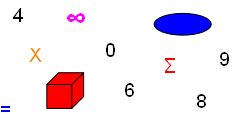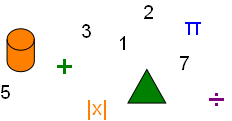



Factoring by Completing the Square


All quadratic equations in one variable can be solved using the method of Completing the Square. This method depends upon the fact:
(a + b)2 = a2 + 2ab + b2
The middle term is twice the product of the square roots of the other two terms:
2ab = 2√a2√b2
Factor 5x2 − 30 = x2 − 5
5x2 − x2 − 30 + 5 = 0
4x2 − 25 = 0
x2 = 25/4
x = ±√(25/4) = ±5/2
Factor the difficult equation 2x2 − 7x = x + 14
Place all math terms on one side of the equation.
2x2 − x − 7x − 14 = 0
2x2 − 8x − 14 = 0
x2 − 4x − 7 = 0
There is no number combination of the constant
14, [ 1, 14 ] and [ 2, 7 ], that when factored using the
“(x ) (x )” setup are equivalent to the original equation.
However, x2 − 4x of the quadratic equation is almost a perfect square.
The perfect trinomial square x2 − 4x + 4 has factors (x − 2) (x − 2).
(x − 2) (x − 2) = x2 − 4x + 4
Isolate the almost perfect square to one side of the equation (very important math step).
x2 − 4x − 7 = 0
x2 − 4x = 7
Use the math Substitution Property.
x2 − 4x = 7
(x − 2) (x − 2) = 7 + 4
(x − 2)2 = 11
x − 2 = ±√11
x = 2 ±√11
To determine the missing term of x2 + 6x to complete a perfect trinomial square:
Apply the form (a + b)2 = a2 + 2ab + b2,
x2 + 6x = a2 + 6a, and
2ab = 6a, then
2b = 6
b = 3, and
(a + 3)2 = a2 + 2a3 + 32, and
(a + 3) (a + 3) = a2 + 6a + 9, when a = 3
Check the equation is correct for values of a = 3 and b = 3
(a + b)2 = a2 + 2ab + b2
(3 + 3)2 = 32 + (2) (3) (3) + 32
62 = 9 + 18 + 9
36 = 36 is correct.
The perfect trinomial math square is:
x2 + 6x + 9 = 36, can be factored as
(x + 3)2 = (3 + 3) (3 + 3) = 36 when x = 3,
and equals 0 when x = −3
Copyright © DigitMath.com
All Rights Reserved.